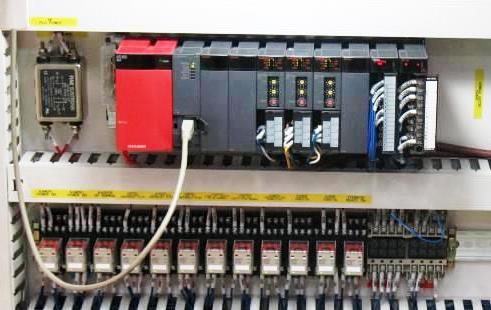Programmable logic controllers (PLCs) first hit the scene in the late 1960s. The primary reason for designing such a device was eliminating the large cost involved in replacing the complicated relay based machine control systems for major U.S. car manufacturers.
Some companies proposed schemes based on the Digital Equipment Corp. DEC PDP-8, the widely-used mini-computer at the time. Dick Morley’s company Bedford Associates in Massachusetts proposed something called a Modular Digital Controller (MODICON). The MODICON 084 brought the world’s first PLC into commercial production.

Since then, a slow steady growth has allowed the manufacturing and process control industries to take advantage of PLC applications-oriented software—programmable language that looks and feels like relay-ladder-logic where any maintenance technician.
Morley is generally credited with the “invention” of the PLC. However, there were many others involved in the birth of this landmark development, including the late Odo Struger (from Allen-Bradley, now Rockwell).
Morley said details of the PLC came about on 1 January 1968. Some 35 years later, it is arguably the most widely used product in the industrial automation business, with a worldwide market of several billions of dollars per year. PLC products are available from hundreds of different sources, in many different form-factors (including embedded controllers), and with prices ranging from tens of thousands of dollars (for triple redundant, failure-proof systems) to commodity products at less than a hundred bucks.
Take a look at this History of the PLC, as told to Howard Hendricks by Dick Morley himself. In true Morley fashion, he calls these “fables,” which may or may not have a basis of truth; but he insists, they are the best that his memory can do after all this time.
Read, learn, and enjoy.
The history of the Programmable Logic Controller (PLC) dates back to the late 1960s and early 1970s.
Here’s a brief overview of the key milestones and developments in the history of the PLC:
-
Emergence of Relay-Based Control Systems: Prior to the development of PLCs, industrial control systems relied heavily on hardwired relay-based control panels. These control systems used relays, timers, and other electromechanical components to implement control logic.
-
First Programmable Controller: In the late 1960s, engineers at General Motors (GM) developed the first electronic replacement for relay-based control systems. Known as the “Modicon 084,” this device was designed to simplify the reprogramming process for assembly lines in the automotive industry.
-
Introduction of the Programmable Logic Controller (PLC): In 1971, Dick Morley, along with his team at Bedford Associates, developed the first PLC, known as the “Modicon 184.” The term “Programmable Logic Controller” was coined by Morley to describe this new electronic device. The Modicon 184 utilized solid-state electronic components and allowed for the programming of control logic using ladder logic diagrams.
-
Advancements and Widespread Adoption: Throughout the 1970s, PLC technology continued to advance, with improvements in memory capacity, processing power, and communication capabilities. As the benefits of PLCs became apparent, their adoption rapidly expanded across various industries, including manufacturing, process control, utilities, and more.
-
Evolution of PLC Programming Languages: Over time, PLC programming languages expanded beyond ladder logic to include other languages such as Function Block Diagram (FBD), Structured Text (ST), Instruction List (IL), and Sequential Function Chart (SFC). These languages provided more flexibility and allowed programmers to use different approaches to implement control logic.
-
Integration with Computers and Networks: In the 1980s and 1990s, PLCs started to integrate with computers and networks, enabling improved communication, data exchange, and remote monitoring capabilities. SCADA (Supervisory Control and Data Acquisition) systems were often used to interface with PLCs and provide centralized control and monitoring.
-
Open Standards and Interoperability: As the PLC industry grew, standards such as the IEC 61131-3 standard were established to promote interoperability and programming consistency among different PLC manufacturers. This allowed programmers to use a common set of programming languages and facilitated the exchange of PLC programs.
-
Advancements in Hardware and Software: PLC technology has continued to advance with innovations in hardware, including smaller form factors, increased memory, faster processors, and enhanced I/O capabilities. Software advancements have improved programming environments, diagnostics, visualization, and integration with other systems.
Today, PLCs are widely used in industrial automation and control systems, playing a crucial role in controlling a wide range of processes and machinery. They have become an essential component in various industries, enabling efficient and reliable control of complex systems.
